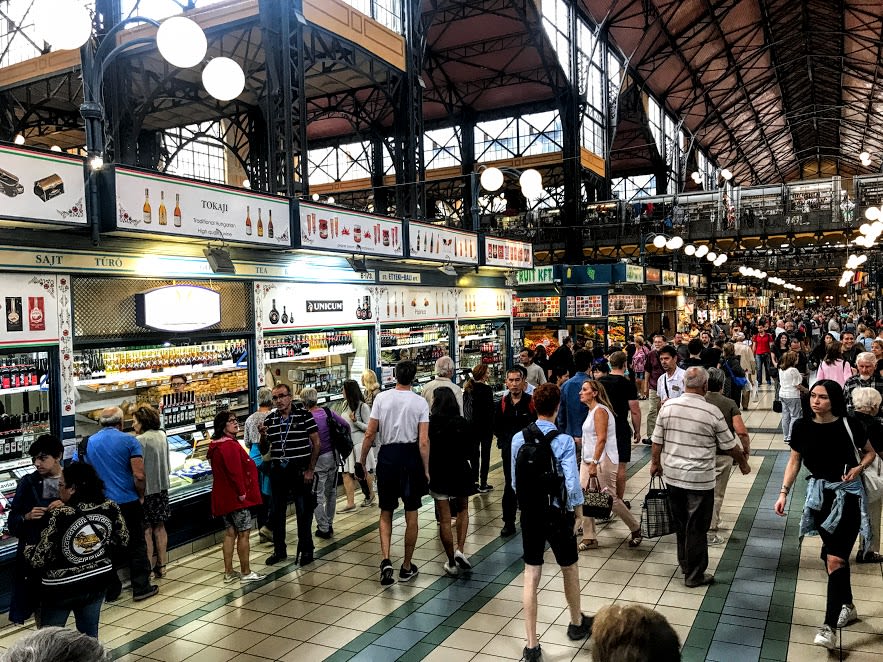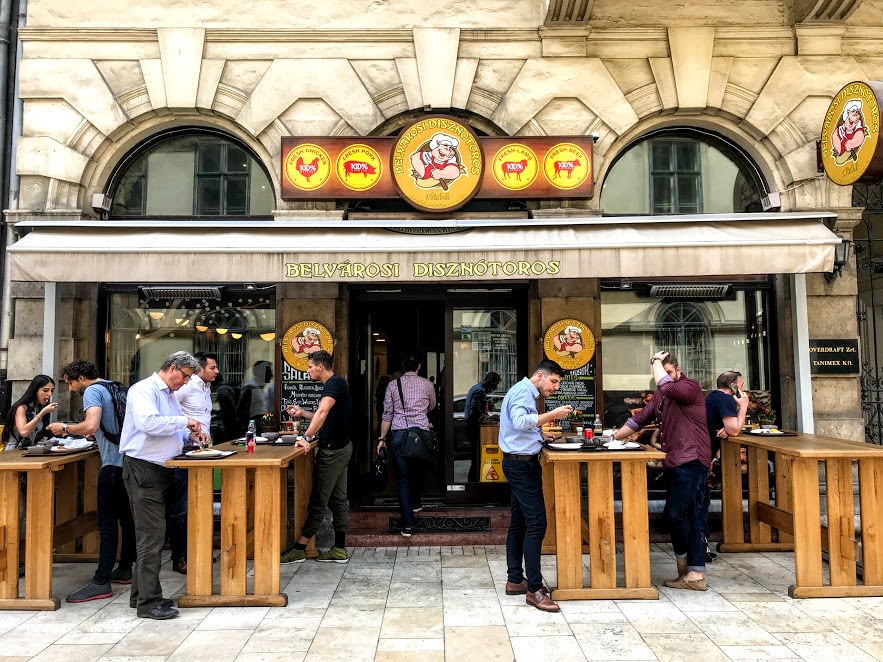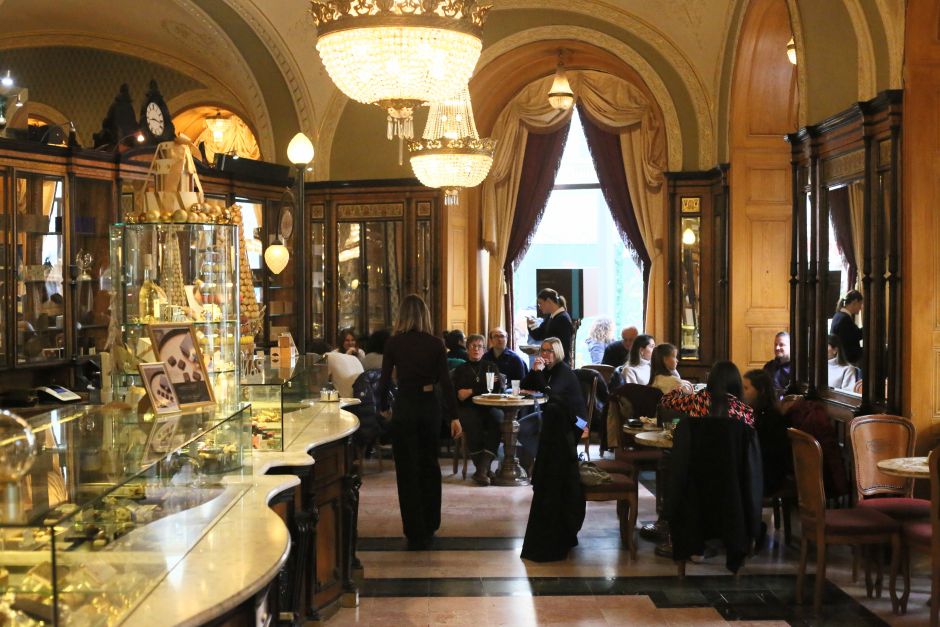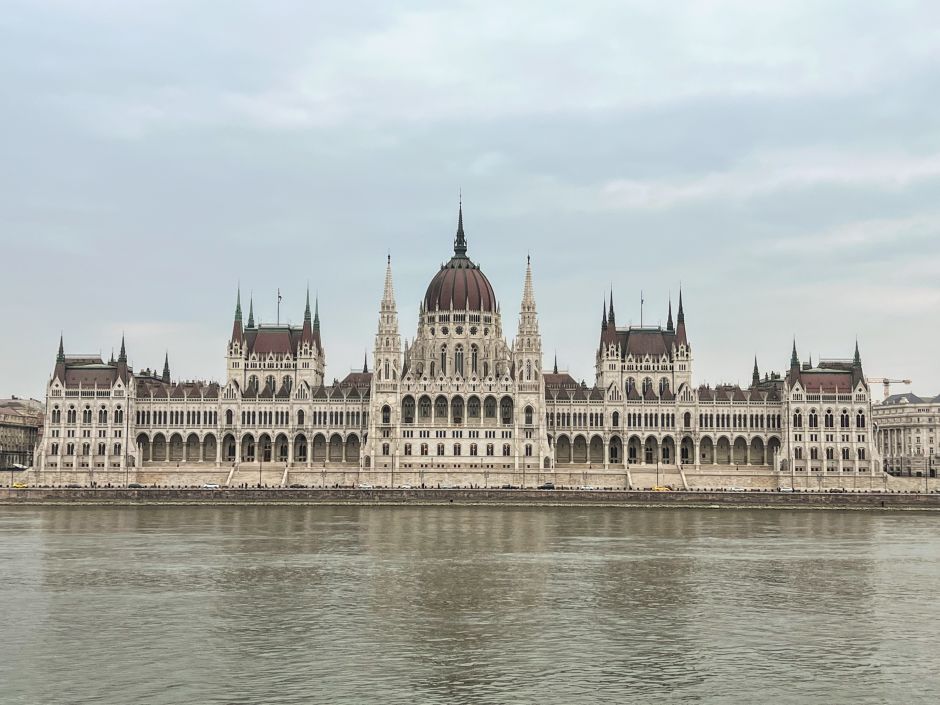Budapest's downtown offers tourist attractions and fine dining restaurants, but there are also under-the-radar parks, restaurants, and cafes that are worth your attention.

Use this map to find all places mentioned in the article below.
Budapest's downtown (District 5) occupies a narrow north-south axis along the Danube's bank on the Pest side. In 40 minutes, you can walk from one end to the other at a leisurely pace. Unlike in Buda, little has remained of the medieval old city of Pest: a sweeping 19th-century renewal program replaced the flimsy old buildings with monumental architecture that better symbolized the city's elevated status in the Austro Hungarian Empire (similar to Haussmann's renovation of Paris).
Today, Budapest's downtown is a melting pot of local residents, office workers, and tourists. Many tourist sites – the Hungarian Parliament building, the Shoes on the Danube Bank, the St. Stephen’s Basilica – and the city's top restaurants are based here. But amid the thronged streets, there are also some uncrowded areas and charming, low-priced food and drinking joints.
Although officially part of Ferencváros (District 9), you could start your trip at the Great Market Hall, on the southern tip of downtown, and work your way up from there. This massive, 19th-century steel and brick building was the city's first indoor market, and today, still, locals and tourists flock here for seasonal fruits, fresh and pickled vegetables, and paprika-laced salami and szalonna. Upstairs, there are souvenir shops, and food stalls hawking lángos, a disc of fried dough showered in sour cream and cheese.

Across the market sets off Váci utca, a famous pedestrian shopping street. It's lined with overpriced souvenir shops and restaurants coaxing tourists with "goulash menus" and pretty hostesses. Think of it as the La Rambla of Budapest. Although Váci Street is worth a visit, I recommend you not spend too much time or money here.
Instead, turn right on Szerb utca, where you'll pass the Saint George Serbian Orthodox Church, built in the 18th century for Budapest's once-numerous Serbian community that found refuge here when Ottoman Turkey occupied the Balkans but Hungary no longer. Further down the street on Egyetem tér stands the imposing law school that breeds the Hungarian political elite.
From here, amble down Henszlmann Imre utca until you reach Magyar utca, which is one of those peaceful side streets that escaped the bulldozers and retained an air of small-city charm. Along here ran Pest's medieval city wall, of which bits and pieces have survived – if you catch the concierge at #36 in a good mood, he'll let you glimpse at it inside the building's staircase.
Back on Magyar utca, the cute park before you is Károlyi-kert, a precious patch of peace and quiet within downtown. Before WWI, it was the private garden of the noble Károlyi family as was the estate attached to it which currently houses the Petőfi Museum of Literature. The residential apartments overlooking the park are some of the most expensive and sought-after in Pest. During the warmer months, Csendes Társ is an ideal stop for coffee, snacks, or wine.

Bookworms, heads-up: Múzeum körút, around the block from here, is the home to antique bookstores. Like it or not, specialty coffee shops have started to replace them at an alarming rate. The books are generally in Hungarian, but you can find small English sections here and there. I'm most taken with Weöres Sándor Antikvárium (#27), a hole in the wall where you have to crane your neck to find the witty shop assistant hiding behind walls of books.
Back on Károlyi Street is Belvárosi Disznótoros, a standing-only sausage shop that counted the late Anthony Bourdain among its fans. Like a local, go for a paprika, blood, or liver sausage, pairing it with a dollop of mustard and a thick slice of bread. There are two old-school bars nearby that offer low-priced drinks and a journey back in time: Ibolya and Grinzingi. After a hiatus, the elegant Central Cafe has sprung back to life. It's one of the few coffeehouses that harkens back to the Austro Hungarian Empire and their Dobos torte won't disappoint. If specialty coffee is more your speed, try Madal just steps away.

Your dreamy stroll will come to an abrupt end at Kossuth Lajos Street, a crowded, six-lane avenue piercing through downtown. Not far from here is FUGA, an architecture bookstore and exhibition venue with books in both Hungarian and English. Turn right on Pilvax köz and head to the quiet square flanked by pre-war buildings. If you enjoy a comfortably classic ambiance, try Gerlóczy Café for a drink or dessert (across from here is house where the famous war photographer, Robert Capa grew up in).
Distinctly hipster vibes exude from the Röser interior courtyard a bit further down, where bearded and tattoed baristas serve pricey cups of specialty coffee at Kontakt with a strict no-milk and no-sugar policy. Next door is Szimply, a similarly trendy breakfast-all-day joint run by the same owners.
From here, head to Szervita Square for an interesting mix of architecture. The Madonna statue is ringed by a Baroque (#6; built in 1732), a pre-modern (#5; 1911), a Renaissance Revival (#4; 1875), a Hungarian Art Nouveau (#3; 1906), a Viennese Art Nouveau (#2; 1908), and a neoclassical (#1; built in 1820) building. All of them are towered over by a recently completed white box. Note the enormous mosaic atop the Art Nouveau building – Török Bankház – whose ground floor is occupied by the buzzing À la Maison Grand breakfast restaurant.
The epicenter of downtown is Deák and Erzsébet Square, a popular meet-up spot for locals. The odd-looking hole in the ground is where Budapest's National Theater was supposed to stand before politics interfered; the area is now home to the Akvárium Klub concert venue. During the summer months, young people fill the park until the wee hours. The polished limestone-clad building of the Ritz Carlton used to be the headquarters of the Adriatic Insurance Company, back when Hungary had sea access (until 1920).
Váci Street ends at Café Gerbeaud, an iconic café and pastry shop dating back to 1858. Drop in for a pricey Esterházy cake to appreciate the gilded interior complete with crystal chandeliers, marble-topped tables, and cherrywood paneling. Right outside Gerbeaud is a subway station of the Millennium Underground, the first subway line on the European continent and currently a Unesco World Heritage Site (it's still operational).

Another pricey but historic venue is Kollázs Brasserie & Bar on the ground floor of the Four Seasons Hotel. This monumental Art Nouveau building overlooks the Danube and the Castle Hill across the river. Get your camera ready before you enter the jaw-dropping lobby with a glass roof and glazed ceramic wall panels. From here, saunter down Zrínyi Street to the St. Stephen's Basilica, the tallest building in Budapest with panoramic views to match from its cupola. For a comparable vista but also a drink in hand, visit High Note Skybar atop the nearby Aria Hotel.
Budapest’s fine dining restaurants cluster around the center of downtown. Apart from Michelin-starred Borkonyha and Costes Downtown, also here is MAK Bistro. My favorite sit-down restaurant for a traditional Hungarian meal is Café Kör. The mecca for specialty coffee in downtown is Espresso Embassy, a true hipster wonderland.
If you enjoy architecture, take a detour for a glimpse of the Central European University on Nádor Street – the building delicately blends old and new (feel free to also go inside). Nearby Liberty Square is known for its grand buildings, including the former stock exchange and the National Bank, as well as the obelisk to Soviet troops who liberated Budapest and the Jewish ghetto in 1945.

In 2014, a controversial WWII memorial sprung up here that symbolically frees Hungary from the crimes commited during the Holocaust, blaming it on the German occupation (here's a summary of Budapest's Jewish history). Made by distraught local civilians, a "protest memorial" stands right before it.
This part of downtown, between Liberty Square and the Hungarian Parliament, is a government and financial district. Politicians, bankers, and tourists run around these stately streets during the day; come night-time, they get eerily deserted. Part of the Parliament, Hungary's biggest building, is open to visitors so you can peek at some of its 691 lavish rooms, including the former Upper Chamber, as part of a 50-minute guided tour. Behind the building, on the Danube's bank, is the poignant Shoes Memorial to Budapest's Jewish victims of the local Nazis.

Near the Parliament sets off Budapest's antique row, peppered with art galleries and high-end antique stores along Falk Miksa Street. Keep a special eye out for Pintér (#10), Artcore (#12), Antikvitás (#12), Pethő (#24), and Virág Judit Galéria (#30).
Downtown terminates at the end of Falk Miksa Street, but Újlipótváros, a lively residential neigborhood located just on the other side of the Grand Boulevard, is also worth discovering.